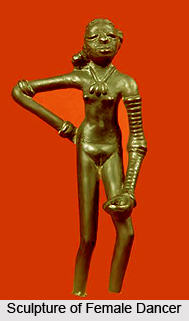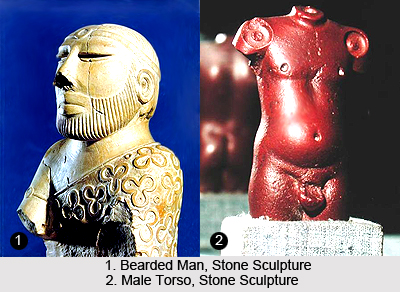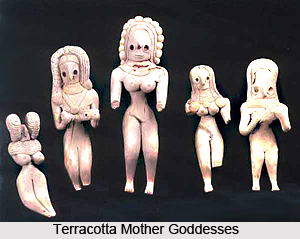 Sculpture of Indus Valley Civilisation is considered to be a golden chapter as the beginning of Indian art and sculpture in 3000 B.C. According to the forms of art excavated from this valley, it can be easily deciphered that the people of this civilization were great lovers of the fine arts especially of dancing, painting, and creating sculptures. The forms of art include various sculptures, seals, pottery, gold jewellery, terracotta figures, and other interesting works of art. The level of achievement that Indian art had attained in those days can be marked with mainly two objects that were excavated from the ruins of the Indus valley. These are the bust of a priest in limestone and a bronze `Dancing Girl` is known for the tremendous sophistication and artistry even today.
Sculpture of Indus Valley Civilisation is considered to be a golden chapter as the beginning of Indian art and sculpture in 3000 B.C. According to the forms of art excavated from this valley, it can be easily deciphered that the people of this civilization were great lovers of the fine arts especially of dancing, painting, and creating sculptures. The forms of art include various sculptures, seals, pottery, gold jewellery, terracotta figures, and other interesting works of art. The level of achievement that Indian art had attained in those days can be marked with mainly two objects that were excavated from the ruins of the Indus valley. These are the bust of a priest in limestone and a bronze `Dancing Girl` is known for the tremendous sophistication and artistry even today.
Metal Sculptures of Indus Valley Civilization
The Harappan artisans were dexterous in the sphere of bronze casting and employed the lost wax process while sculpting figurines, which implies coating the wax idols with clay. The bronze statue of the `Dancing Girl` belonging to Mohen-jo-Daro is notable. It depicts a female dancer whose one arm is covered with ivory or bone bangles and is adorned with necklaces. Braided hair, head slightly tilted back, flat nose and large eyes are the salient features of this work. Bronze figures of a humped bull and a buffalo are the other metal sculptures made during this period.
Stone Sculptures of Indus Valley Civilization
There exists several specimens of stone sculptures which were crafted during this civilization, of which two male statues deserves a special mention and consist of the statue of the `Bearded Man` and `Human Torso`.
 One will derive the idea of a high priest or a king clad in a shawl draped over the left shoulder, with a well-maintained beard, if he observes the figure of the Bearded Man. Another impressive stone sculpted statue is that of a naked human male, made in red stone. The arms and head of this idol have been created separately.
One will derive the idea of a high priest or a king clad in a shawl draped over the left shoulder, with a well-maintained beard, if he observes the figure of the Bearded Man. Another impressive stone sculpted statue is that of a naked human male, made in red stone. The arms and head of this idol have been created separately.
Terracotta Sculpture of Indus Valley Civilization
Terracotta art was also practised by the people of Indus Valley. The figure of the Mother Goddess crafted in terracotta, discovered in Mohen-jo-Daro is one of the significant terracotta sculptures of this age. It consists of beautiful embellishments of the body and a punched nose, and reveals the concept of the Mother Goddess as a sign of prosperity and fertility. Terracotta seals were also manufactured. These seals included the carvings of peepal leaves, female figurine with forms of deities and animals. All these definite & distinct shapes of stones or seals were enshrined and worshipped during that time by people of the civilization. Some of these seals also depicted a harp -like musical instrument, which confirm the presence of stringed musical instruments which were in use in this ancient civilization.
Animal Sculpture of Indus Valley Civilization
Indus valley sculptures also emphasized more on civic life. So, animal sculptures were found their presence in every form of them.Animals like elephants occupied a special place in the life and artistic tradition of India, right from the Indus Valley Civilization to date. Elephants were depicted in the architectural sculpture. At the places like centuries-old temples, monasteries, forts and palaces, elephants were carved for making the ceremonial entrances. In most of the cases, sculptures of animals from Harappan civilization denote every minute detail; for example the bottom of the statue depicts the animal is in sitting position, but even though the hidden leg was originally indicated in the final appearance without its direct & visible denotation.
 And is numerous cases, the entire body of the animal is carved within a single unbroken outline & in single rock. In fact, the combination of closed outline balanced with broadly modelled masses and a minimum of incised detail can be said as the characteristic of animal sculpture from the Harappan-period.
And is numerous cases, the entire body of the animal is carved within a single unbroken outline & in single rock. In fact, the combination of closed outline balanced with broadly modelled masses and a minimum of incised detail can be said as the characteristic of animal sculpture from the Harappan-period.
Like elephant, another animal found in Harappan civilization that is noted for the sculptural appearance is `Nandi`, the `vahana` of Lord Shiva. The close association between Shiva and Nandi can be marked with the presence of a statue of Nandi at the gate of the `Garbha Griha` of every temple that is dedicated to Shiva. Another animal found in the sculptures is the lion - the vahana of Goddess Durga. So, carving sculptures of her, along with her other attributes the lion is also carefully carved. The bronze images or other metallic images denote the lion in realistic way. But apart from artistic tradition the function of these animal sculptures is still unknown.
Other forms of Indus Valley Sculpture
The most striking feature of the Indus Valley Civilization was found that emphasis on the organization of everyday civic life. The jewellery made during that time by Indus craftsmen gives detail of their perception towards the artistry. Other objects offer tantalizing, but partial glimpses about the daily life and beliefs of the Indus people. Shell objects were obtained from Lothal, one of the cities of Indus Valley.



















